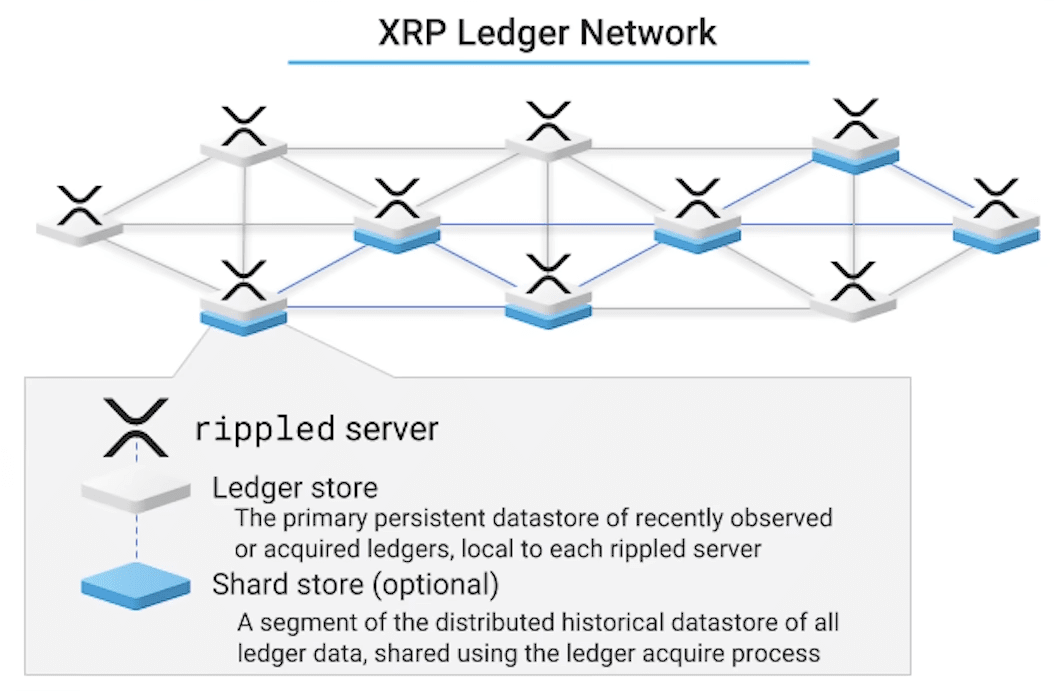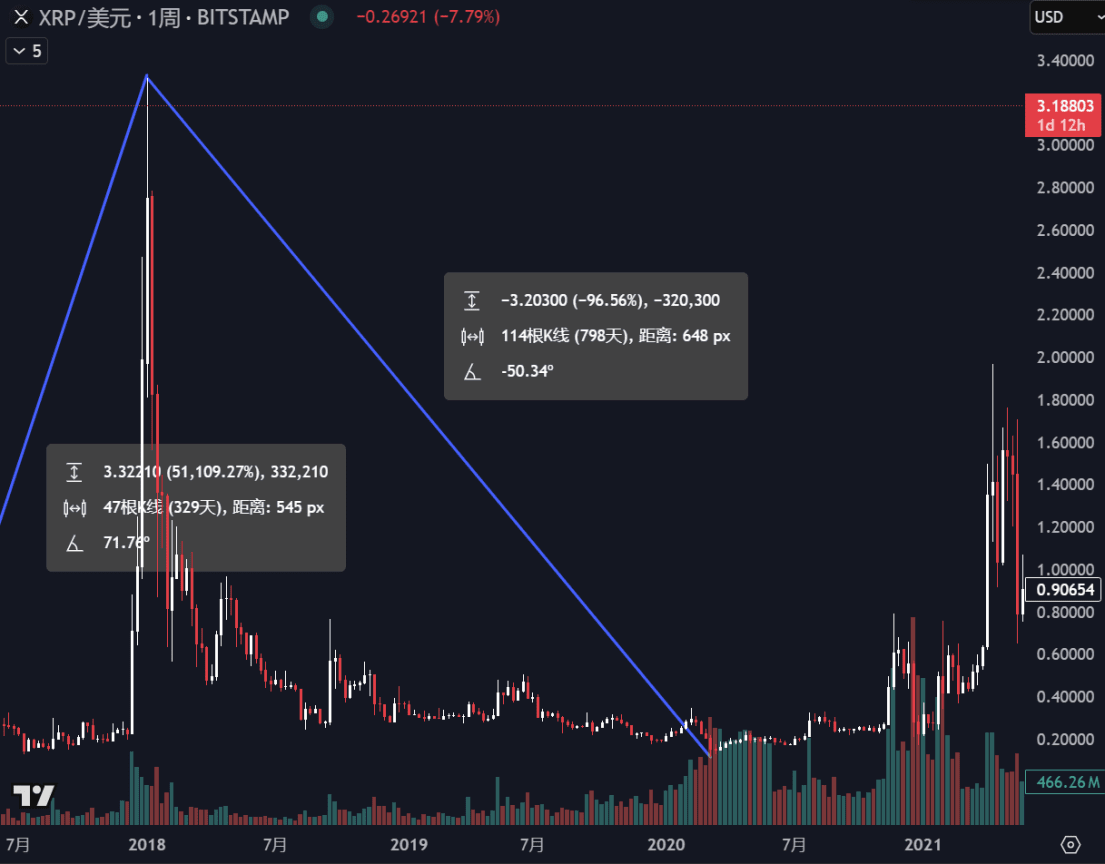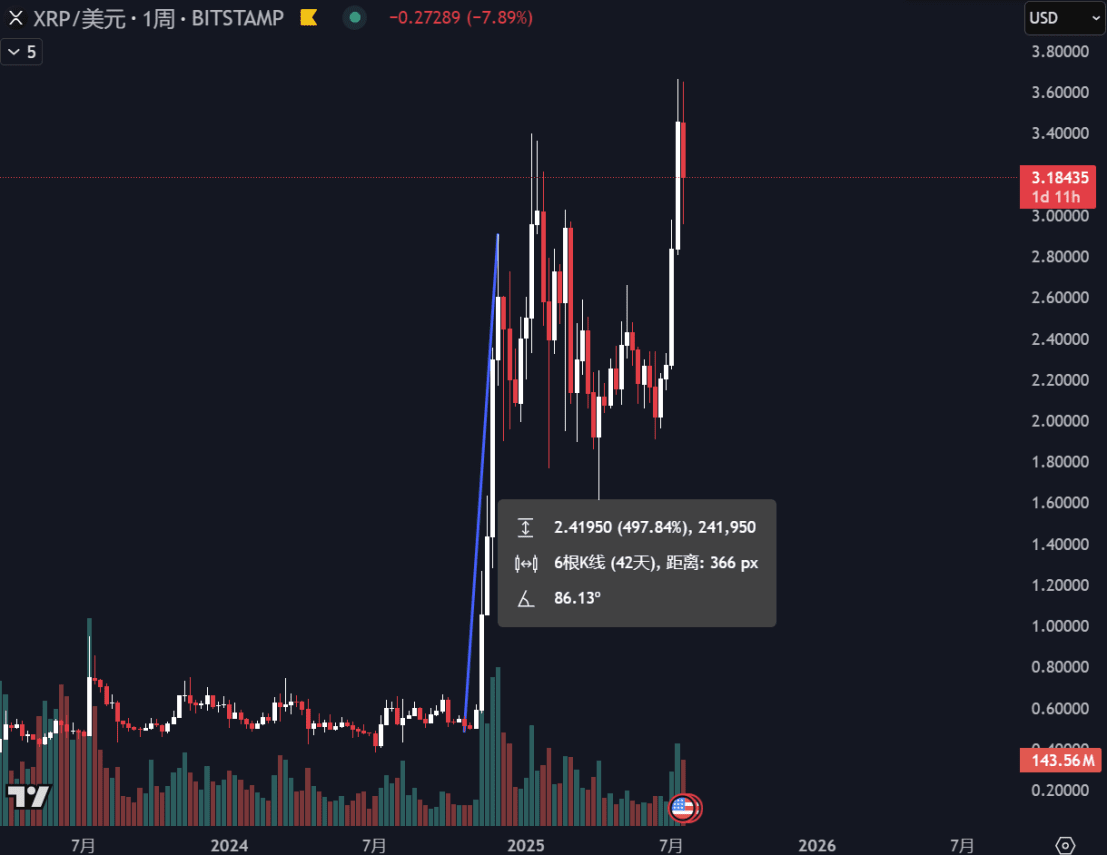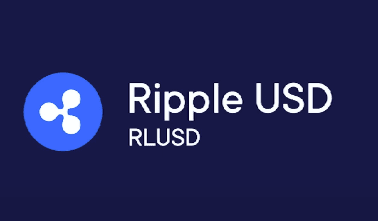From the altar to the bottom, then back to the center of attention
As early as the peak of the bull market in 2017, XRP's market value once surpassed Ethereum, and even its founder Chris Larsen's wealth exceeded that of Google's founders, being hailed by the media as a 'potential world richest'.
However, in just a few months, the price of XRP plummeted 90% in a single month, was delisted by Coinbase, and became the 'street rat' of the cryptocurrency world.
But after 2024, the wind direction changes again. The Biden administration steps down, Trump returns, and cryptocurrency policies become more friendly. XRP unexpectedly becomes one of the 'digital asset reserves' of the new U.S. government after ending its years-long lawsuit with the SEC.
Ripple and XRP have once again become the focus of the market.
What is XRP? Who is Ripple Labs?
XRP, commonly known as "Ripple Coin" in Chinese, is issued by Ripple Labs. However, the concept of Ripple actually existed as early as 2004.

Its original founder, Ryan Fugger, is a Canadian developer.

He noticed that the financial system at the time was extremely unfriendly to people with cash income. Even if you had a stable income and good credit, it would be difficult to get a loan just because you didn't have a bank statement.
To this end, he proposed an innovative concept: "RipplePay" - a peer-to-peer lending system based on community trust and not relying on banks.
For example:
You want to buy a 500,000 yuan car from Wang Wu, but the bank refuses to lend you money because you're a freelancer. However, your friend Zhang San knows you can repay the loan, and Zhang San has a friend named Li Si, who knows Zhang San can repay the 500,000 yuan. Wang Wu, the seller of the car, also happens to know Li Si. Thus, a network of social trust creates a "credit chain," completing a transaction without institutional involvement or cash settlement.
However, this system, which relies too much on "personal trust", is difficult to expand into a global financial structure.
A talented addition: Jed McCaleb
In 2011, crypto legend Jed McCaleb found Ryan.
This person has an extraordinary background: a dropout from the UC Berkeley Department of Physics,
A pioneer in P2P sharing technology (created eDonkey): a peer-to-peer file sharing platform. In an era before Spotify and NetEase Cloud Music, when genuine CDs and albums were expensive, Edonkey allowed users to share music and movies directly with each other. It was hailed as a "god site" by students at the time and is considered a pioneer in peer-to-peer file sharing technology.
He created the world's first mainstream Bitcoin exchange, Mt. Gox. Magic the Gathering Online Exchange was originally intended to allow people to freely trade genuine Magic the Gathering cards, but soon after, the platform transformed into a Bitcoin exchange and became the first exchange in history to dominate the entire network, Mt. Gox. Of course, in 2011, Jed had already Sold the company. So the success of MtGox and the subsequent hacking incident should not be entirely attributed to him.
Sold the company. So the success of MtGox and the subsequent hacking incident should not be entirely attributed to him.
Jed is a geek by birth, but he is keenly aware of the huge flaws of Bitcoin - slow transaction speed, poor scalability, and high energy consumption.
He set out to develop a faster, more environmentally friendly distributed ledger technology that would not require mining, and came across RipplePay during his research.
Thus, the two concepts produced a spark of fusion:
Jed's vision: decentralized, efficient ledger technology + Ryan's philosophy: a trust-based payment network = XRP Ledger

In 2012, Ripple Labs was officially established.
Technology + Capital Dual Engine: Chris Larsen Joins
To disrupt traditional finance, technology alone is far from enough. Jed brought in Chris Larsen, an orthodox Wall Street elite and founder of E-Loan, the largest online loan platform in the United States at the time.
Chris has received investments from giants like SoftBank and Yahoo, and his company was ultimately successfully listed and acquired. More importantly, he understands the banking industry, understands compliance, and excels at financing.
He and Jed are an ideal pair:
Jed provides technological revolution, and Chris brings commercialization and capital integration.
However, the good times did not last long.
Diverging ideals: decentralization vs. banking collaboration
Jed hopes to build a completely decentralized system that allows people around the world to transfer money freely without relying on banks.
Chris, on the other hand, is more pragmatic – he hopes that Ripple will become the underlying system for banks to upgrade cross-border payments. This "institutionalization" approach is seen as a "betrayal" by some crypto believers.
As the company's shares changed, Chris gradually took control of Ripple Labs, while Jed angrily resigned in 2014 and founded another project, Stellar (XLM).

Stellar continues Jed’s original intention of “free payment”.
XRP's "Alternative Success": Institutional Cooperation + Regulatory Friendliness
Ripple Labs has gradually transformed from a "crypto idealist" to an "enterprise service provider":
Cooperate with 12 banks including Standard Chartered, Credit Suisse, and Canadian Imperial Bank of Commerce
Established a joint venture with SBI Holding to promote payments in Asia
Actively cooperate with the US SEC review and promote compliance
This made XRP stand out during the 2017 “ICO bull market.” While many altcoins were still at the white paper stage, XRP had already been implemented and was deeply integrated into traditional finance.
From 2016 to the end of 2017, the price of XRP soared 500 times, and Chris Larsen once ranked fifth on the world's rich list, surpassing Google founder Larry Page and Facebook's Zuckerberg.
The Bubble Burst: A Lesson in Greed and Fear
But in the end, what was written into history textbooks was not the "XRP wealth creation myth" but "FOMO" (fear of missing out).
The first time I heard of “Bitcoin” was after the bull market crash in 2018. At that time, the first word that newcomers to the cryptocurrency world learned was not “blockchain” but:
Don’t be afraid of missing out
At the end of the bull market, XRP saw a 30-day rally, with daily gains of nearly 30%. You might have called it a bubble for 29 days straight, but on the last day, seeing someone earning 10 years' worth of your money with it, how could you not be tempted?
It's not greed, it's fear-driven emotion to buy an asset you're not familiar with.
I haven't experienced this kind of situation, but I think it would be hard for me to control my emotions in this situation.
Market reversals often occur at the climax of the "national fear of missing out".
The bubble will eventually burst: XRP's decline and the regulatory black swan
By the beginning of 2018, the atmosphere in the crypto market had taken a sharp turn for the worse.
The U.S. Securities and Exchange Commission (SEC) launched a comprehensive investigation into ICOs, with many projects deemed to be illegal securities offerings and even founding teams absconding. The market panicked, with new tokens facing a sell-off and established projects facing a sell-off. Exchanges closed, investors fled, and the myth of ICOs shattered.
Bitcoin plummeted from $19,000 to $3,000, and XRP was not immune. In just six months, the price of the coin plummeted 90% from its historical high.

XRP plummeted 97%. How many institutions failed here, and how many families and individuals were burdened with huge debts here.
To make matters worse, the market began to reflect on the previous narrative of XRP’s “cooperation with banks”.
Most of these so-called "collaborations" involve only the RippleNet communication protocol, not actual liquidity needs. The so-called "financial institution certification" simply refers to some banks establishing blockchain research groups. To claim this is a "good news" supporting a multi-billion dollar market capitalization is far-fetched.
The Gavel Falls: SEC Litigation in 2020
In December 2020, when the entire cryptocurrency industry was preparing to welcome the DeFi bull market, the SEC swung the knife again, and this time the target was Ripple.
The accusation: Ripple issued XRP as an unregistered security. This led to exchanges like Binance and Coinbase delisting XRP. The once star cryptocurrency project, once atop Ethereum, suddenly became a classic example of illegal activity.
This lawsuit is not only a symbol of the regulatory storm, but also an ironic proof of XRP's "recourse to traditional finance" in the mouths of decentralization believers.
Since then, XRP has been marginalized in the crypto market for almost the entire period of 2021-2023. Especially in the Chinese-speaking community, its presence has almost been reduced to zero.
Political Winds Shift: Trump Returns, XRP Reborn
It wasn't until November 2024 that the U.S. political landscape underwent a dramatic change - Donald Trump was re-elected president and became the first president in history to openly support cryptocurrency.
His appointment was not only a shift in attitude, but also had a direct impact on policies and personnel:
Former SEC Chairman Gary Gensler Resigns, Replaced by Crypto-Friendly Paul Atkins
Treasury Secretary Appoints Scott Bassant, Supporter of Stablecoin Legislation
The Secretary of Commerce is Howard Lutnick, who supports comparing Bitcoin to gold.
Web3 investor David Sacks appointed the new "Cryptocurrency and AI Czar" position
In terms of policy, Trump announced:
Build the United States into the "global cryptocurrency capital", promote the legislation of US dollar stablecoins, and include five mainstream cryptocurrencies in the U.S. Treasury digital asset reserves.
Surprisingly, XRP is on the list.
Explosive rise: XRP creates miracle again
In the month Trump won the election, Bitcoin rose 30%. XRP, on the other hand, saw a rare 500% surge in a single month, from $0.5 to $2.7, rivaling the crazy growth during the 2017 bubble.

What supports this wave of market is not only policy support, but also a key turning point:
The departure of the old SEC leadership represents the lifting of the regulatory shadow;
Wall Street’s entry means a shift in capital momentum.
New institutional investors are less concerned with decentralization than with compliance, liquidity, and efficiency. Ripple, with its years of experience in developing interbank cross-border payment systems, represents the underlying infrastructure they value.
Parting ways with Ethereum: Ripple’s goal has never been to build an on-chain ecosystem
Many crypto players question XRP: You have neither a DeFi ecosystem nor an NFT craze, and you haven’t even caught up with blockchain games. Why are you rising?
But this precisely reflects Ripple's positioning - it has never been an on-chain world built for retail investors, but an underlying clearing system serving traditional financial institutions.
If you have no experience in international remittances, it is indeed difficult to understand its significance - this matter is not that simple.
The traditional approach to cross-border payments: complex, time-consuming, and expensive
Imagine you are in Tokyo and want to transfer 100,000 yen from Bank A to a friend at Bank B in the Philippines and exchange it for Philippine pesos. This may seem like a simple operation, but the actual process is extremely complicated:
Bank accounts are independent and funds must flow through intermediary banks
If Bank A and Bank B do not have a common intermediary, two or three intermediary banks may be needed
Each intermediary bank manually confirms the transfer information during local business hours
Each transfer must undergo KYC, AML and other compliance reviews
Most banks have to go through two foreign exchange markets, from yen to dollars to pesos, which results in high fees.
The most critical problem is that you can’t immediately know the progress of the remittance. All this is because we are still using a system designed in 1973 - SWIFT.
Ripple’s solution: XRP Ledger and ODL system
Chris Larsen saw this problem and argued that modern finance requires a high-speed, secure, environmentally friendly, and compliant cross-border clearing network.
Ripple uses a blockchain ledger architecture, but unlike Bitcoin's power-consuming PoW, it uses the RPCA consensus mechanism (Ripple Protocol Consensus Algorithm):
Each node has a pre-set trust list (UNL)
As long as 80% of the nodes in the list confirm, the transaction is established
No mining required, zero energy consumption, and an ideal TPS value of up to 50,000
XRP Ledger provides:
Global unified ledger: no need for multiple intermediary banks
Automatic settlement mechanism: Eliminate manual processes and time constraints
ODL liquidity system (On-Demand Liquidity):
Currency exchange can be completed even without a trading pair
Use XRP as an intermediary currency to exchange XRP first and then exchange it for the target currency
For banks, this means reduced costs, increased efficiency, and controllable compliance.
Ripple from a Banking Perspective: Not the "Ideal Blockchain," but Possibly the "Realistic Answer"
From the perspective of a crypto geek, XRP may not be considered a "pure blockchain" project.
But from the perspective of bank executives, this is a technical solution that solves the biggest pain points at the lowest cost.
It may not be as "decentralized", but it is more "practical".
From “potential” to “reality”: XRP’s next chapter is unfolding
As of early 2025, more than 400 financial institutions around the world have used Ripple's services, including partners such as Bank of America, Santander, Standard Chartered Bank, DBS Bank, UBS, American Express and other established financial giants.
As stablecoin legislation rapidly advances in the U.S. Congress, Ripple has also launched its own stablecoin project, RLUSD, which is expected to be launched in the second half of 2025. It is worth noting that all this may just be the beginning.

Ripple's goal has never been the present, but the complete reconstruction of the global cross-border payment system in the future.
Understanding XRP: Not Just Valuation, But the Landscape
Many people tend to use stock market-like metrics like PE and EPS to price XRP. However, there has never been a unified valuation formula for cryptocurrencies.
For an institutional payment token like XRP, price fluctuations are not only related to fundamentals but also deeply influenced by market sentiment (FOMO) and policy expectations (FAD). Therefore, rather than trying to calculate a "fair price," it's more important to understand the factors that drive or suppress XRP's price.
XRP is targeting the largest market in cryptocurrency
Ripple Labs, the company behind XRP, is targeting the largest and most in-demand scenario in the entire crypto industry: the cross-border settlement market, especially “wholesale payments” between institutions.
The data shows:
The global cross-border payment market will reach US$194.6 trillion in 2024.
Institutional wholesale payments accounted for nearly 80%, or approximately $154 trillion.
Assuming that only 1% of the payment market is covered by Ripple technology in the future, that would mean $1.5 trillion in funds being cleared through XRP every year.
Ripple CEO Brad Garlinghals even publicly stated at the 2025 Singapore APEX Summit:
“In the next five years, XRP is expected to replace 14% of the settlement volume of the SWIFT system.”
In other words, XRP could potentially participate in the $40 trillion payments market. [Illustration 15: Cross-border payments market size chart + Ripple share hypothesis model]
Behind this is not only the bank's demand for funds for "buying coins and clearing", but also:
Locked coin requirements for reserve payments
Ripple collects fees to burn XRP, creating deflation
The liquidity premium brought by the future stablecoin synergy mechanism
This means that if Ripple really occupies the position of mainstream clearing chain, today's XRP price - even if it has risen to $2, may only be the beginning.
ETF Expectations: XRP Could Be the “Next Bitcoin ETF”
The biggest hope for many investors holding XRP is the incremental funds brought by the approval of the ETF.
Currently, several US asset management giants, including Grayscale and Bitwise, have submitted a total of 12 XRP ETF application documents, awaiting SEC review.
Bloomberg analyst Eric predicts: XRP ETF has an 85% chance of approval
Polymarket's betting market also shows: the probability of passing is as high as 86% (as of April 2025)
If the XRP ETF attracts even one-tenth of the inflow of funds of the Bitcoin ETF, it will be an increase of tens of billions of dollars.
The current market value of XRP is around $120 billion. Once the ETF is approved, it will provide a substantial boost to the price.
The "weakness" of the on-chain ecosystem is being filled
In the past, XRP has long been criticized for "lacking an on-chain ecosystem" and is almost unable to support mainstream on-chain applications such as DeFi, NFT, and games.
But this situation may change drastically by 2025.
Ripple officially announced at the APEX Conference in Singapore in 2025:
XRP Ledger will launch an Ethereum-compatible EVM sidechain, which will go live in the second quarter.
This sidechain is built on the Cosmos SDK and uses the POA consensus mechanism. Its goals are:
Connecting to XRP’s Institutional Financial Ecosystem
Connect to Ethereum's rich DeFi, AI, RWA and other on-chain protocols
Achieve high developability and regulatory-level security
EVM compatibility means that any project developed on Ethereum can be seamlessly deployed to the XRP EVM sidechain.
Especially against the backdrop of the rise of the RWA (real-world asset chain) track and the entry of Wall Street funds:
If the XRP sidechain can provide an institution-friendly, regulatory-compliant, and development-friendly environment, it is likely to become an important bridge for Wall Street to embrace blockchain.
From Institutional Channels to On-Chain Entry: XRP’s Second Rise
Ripple spent 10 years building its "bank partnership"
After Trump took office, policy support became the biggest support for "real implementation"
ETFs are expected to lead traditional funds to buy
On-chain EVM compatibility may open the door to retail investors and DeFi developers
This journey hasn’t been perfect, and Ripple isn’t without controversy. But it’s undeniable that XRP’s story as a blockchain-based institutional payment solution continues to unfold.
A Calm Look at XRP: Two Key Concerns Cannot Be Ignored
While Ripple appears to have a lot of positive news, there are two key risks that you must consider before you decide to invest in XRP.
1. The value capture mechanism is unclear, and tokens are not equivalent to equity
Many people mistakenly believe that if a project performs well, the token price will definitely rise. However, this is only true if the project's value can be effectively reflected in the token, which is known as value capture.
This is common sense in the stock market: if you hold 1% of a company's shares, you can enjoy 1% of the profit dividends.
This is also true in many blockchain projects. For example, Ethereum:
You can get block generation and verification rewards by staking ETH;
ETH, as the gas fee, is the key fuel for the operation of the entire network;
Therefore, the more successful Ethereum becomes, the more valuable ETH becomes.
But in XRP, the situation is different.
Ripple's consensus mechanism uses the UNL (Unique Node List) trust system, and most nodes still rely on the node list recommended by Ripple. Unlike Ethereum, you cannot influence the system through staking or node participation.
In other words, even if you buy all the XRP in the world, you cannot gain any actual control over Ripple's cross-border clearing business.
At the same time, there is no direct correlation between running an XRP node and holding XRP, and a positive closed loop of "equity determines participation" cannot be formed.
2. Financial giants are coming in with great momentum, and competition will become increasingly fierce.
Another hidden concern is the fierce competition in the cross-border payment sector.
Although Ripple has almost no rivals in the cryptocurrency world, the counterattack of traditional financial institutions and government systems is gradually unfolding:
SWIFT system upgrade: It is expected to fully switch to the ISO 20022 standard in November 2025. At the same time, it will cooperate with Chainlink to connect traditional exchange information to the chain through the CCIP protocol.
JPMorgan Chase: Promoting its own bank alliance chain
Visa: Building the next-generation clearing system with USDC
Central banks: Accelerate the development of CBDCs (e.g. MBridge project jointly developed by China, Thailand and UAE)
If you want to enter this market, you will not only have to compete with start-up projects in technology, but also compete with established financial institutions that have resources, political and business connections, and regulatory experience.
Only those who can simultaneously solve the three major challenges of "low cost", "regulatory compliance" and "real-time liquidity" will be able to capture more than 5% of the global market share by 2030.
Ripple did enter the market early and has a strong awareness of compliance. However, the competition it faces is no longer just the "next big cryptocurrency geek," but rather the traditional giants of the financial world.
XRP is one of the most complex projects in the cryptocurrency world.
To be honest, XRP is one of the projects that I have heard people discuss most frequently since I entered the cryptocurrency circle, but I have always found it difficult to fully understand.
In the process of writing this article, our team repeatedly read the white paper, studied official materials, and edited a large amount of relevant content.
We originally spent a lot of time explaining the operating mechanism of the SWIFT system and how Ripple optimizes the efficiency of global capital flows through ODL (On-Demand Liquidity) and mathematical models - but it was too complicated and too difficult, and in the end the editor couldn't make it, so he had to reluctantly delete some of the academic content.
If you've read this far, I want to say thank you for your careful consideration of this project. XRP isn't just a candlestick chart; it represents the convergence and tug-of-war between cryptocurrency and traditional finance.
We hope that this method can help more people truly understand a cryptocurrency project, rather than blindly hype it or chase rising and falling prices based on FOMO.
If you want to participate in this market, you may want to follow me and visit my homepage to learn more. I will express more of my own views in the communication community.
The information provided in this article is for educational and entertainment purposes only and does not constitute financial advice. I am not a financial advisor. Trading can result in the loss of funds. Individuals must consider all risk factors, including their own financial situation, before trading. All individuals are responsible for their own trading and investing. This information is publicly available on the internet and may have been manipulated or distorted by the internet. All information is provided for public awareness and is in the public domain. This information is not intended to slander, harm, or defame any of the individuals involved, but rather to reflect what is being said through their social media accounts. Please obtain relevant information and conduct your own research.


